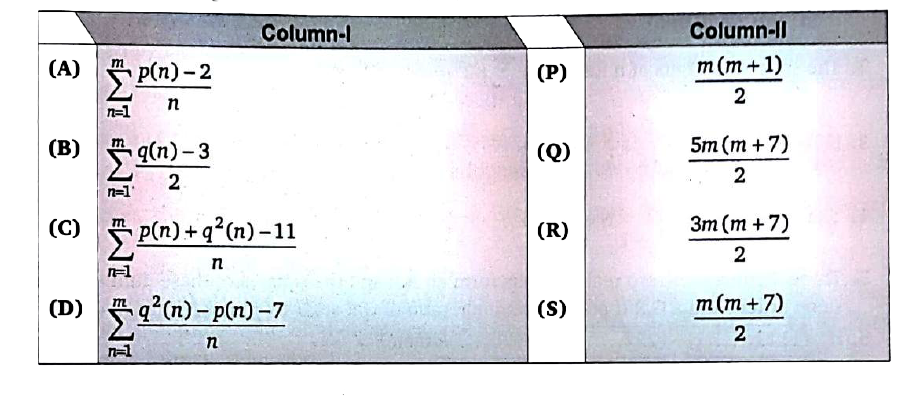Let f(x)=1+12+13+14+………+1n such that P(n)f(n+2)=P(n)f(n)+q(n). Where P(n)Q(n) are polynomials of least possible degree and P(n) has leading coefficient unity. Then match the following Column-I with Column-II.

The correct Answer is:A→S;B→P;C→Q;D→R
Step by step video & image solution for Let f (x) =1+ 1/2+ 1/3+ 1/4 + ……… + 1/n such that P (n) f (n+2) = P ( n) f (n) + q (n). Where P (n) Q(n) are polynomials of least possible degree and P (n) has leading coefficient unity. Then match the following Column-I with Column-II. by Maths experts to help you in doubts & scoring excellent marks in Class 12 exams.
Updated on:21/07/2023Topper's Solved these Questions
- SEQUENCE AND SERIES BOOK - VIKAS GUPTA (BLACK BOOK) ENGLISHCHAPTER - SEQUENCE AND SERIES EXERCISE - EXERCISE (SUBJECTIVE TYPE PROBLEMS)
21 Videos
- SEQUENCE AND SERIES BOOK - VIKAS GUPTA (BLACK BOOK) ENGLISHCHAPTER - SEQUENCE AND SERIES EXERCISE - EXERCISE (COMPREHENSION TYPE PROBLEMS)
16 Videos
- QUADRATIC EQUATIONS BOOK - VIKAS GUPTA (BLACK BOOK) ENGLISHCHAPTER - QUADRATIC EQUATIONS EXERCISE - EXERCISE (SUBJECTIVE TYPE PROBLEMS)
45 Videos
- SOLUTION OF TRIANGLESBOOK - VIKAS GUPTA (BLACK BOOK) ENGLISHCHAPTER - SOLUTION OF TRIANGLESEXERCISE - Exercise-5 : Subjective Type Problems
11 Videos
Similar Questions
Knowledge Check
Let P(n):(2n+1)<2n, then the smallest positive integer for which P(n) is true?
A(a)2B(b)3C(c)4D(d)5
Let f(n)=1+12+13++1n. Then f(1)+f(2)+f(3)++f(n) is equal to
(a)nf(n)−1
(b) (n+1)f(n)−n
(c)(n+1)f(n)+n
(d) nf(n)+n
View SolutionIf the sum of n terms of an A.P. is nP+12n(n−1)Q,where P and Q are constants, find the common difference.
View SolutionLet f:N→R be a function such that f(1)+2f(2)+3f(3)+....+nf(n)=n(n+1)f(n), for n≥2 and f(1) = 1 then
View SolutionFind n if :
2P(n,3)=P(n+1,3)
View SolutionProve the following: P(n,n)=P(n,n−1)
View SolutionIf f(x)=(p−xn)1n ,p>0 andn is a positive integer then f[f(x)] is equal to
View SolutionFind n if :
2n+1Pn−1:2n−1Pn=3:5
View Solution
